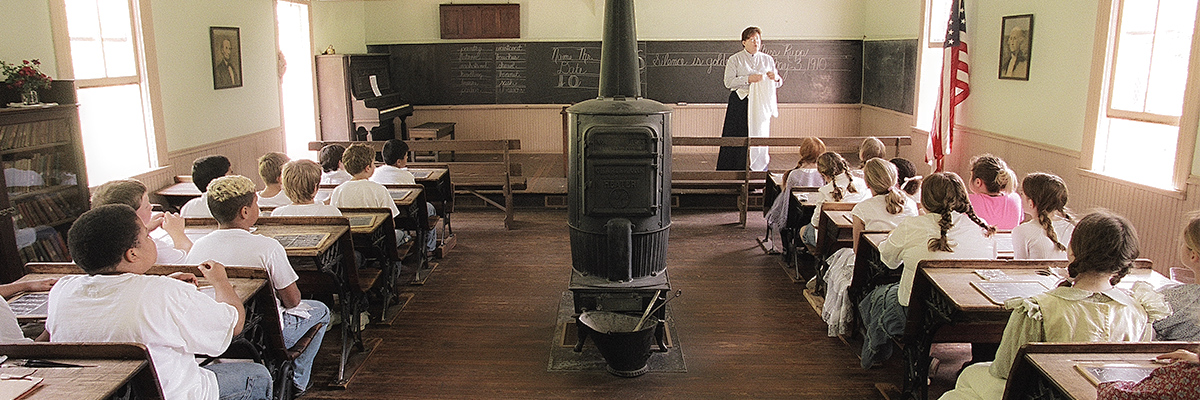
Cherokee Strip Museum and Rose Hill School
Cherokee Strip Museum and Rose Hill School
2617 West Fir Street
Perry, OK 73077
580-336-2405
director@cherokee-strip-museum.org
Director: Madison Flores
Hours
Tuesday through Friday
9 a.m. to 5 p.m.
Saturday
10 a.m. to 4 p.m.
| Adults | $7 |
| Seniors (62+) | $5 |
| Students (6–18) | $3 |
| Family (up to 6 people) | $18 |
| Group Rate (10+) | $5/person |
| OHS Members, Children (under 6), Veterans and Active Military (with ID) | Free |
The mission of the Cherokee Strip Museum and Rose Hill School is to collect, preserve, and interpret the history of the Cherokee Outlet. The museum complex sits on about five acres and includes four buildings: the museum, a blacksmith shop, a large implement building, and an original one-room schoolhouse. The exhibits are designed to portray life from the opening of the Cherokee Strip in 1893 to the 1930s. The museum features exhibits, a gallery featuring works by local and regional artists, a large gift shop, and a hands-on farmyard exhibit for children.
Our blacksmith shop consists of a 24’ x 30’ display area with restrooms and a 36’ x 30’ demonstration area. The implement building contains many farming implements and tools that would have been in use during the late nineteenth and early twentieth century. Other outdoor exhibits include a jail cell, antique threshing machine, antique sorghum mill, and a “flying jenny” merry-go-round for kids.
The museum complex is located approximately a quarter-mile east of I-35 from exit 186 toward Perry. The Cherokee Strip Museum and Rose Hill School is an affiliate of the Oklahoma Historical Society, operated in partnership with the Cherokee Strip Historical Society. To learn more, visit www.cherokee-strip-museum.org or find us on Facebook.
A Day at Rose Hill School
Located on the grounds is a one-room schoolhouse where we conduct the award-winning living history program A Day at Rose Hill School. Throughout the school year, third- and fourth-grade students from across the state can experience a school day set in 1910 rural Oklahoma. The educational program is offered through a partnership between the Oklahoma Historical Society and the Cherokee Strip Historical Society. Learn more about A Day at Rose Hill School.
Cherokee Strip History
In the nineteenth century, the US government resettled American Indian tribes from all parts of the country into Indian Territory. During removal, part of the northern portion of present-day Oklahoma was given by treaty to the Cherokee Nation as a “perpetual outlet west.” Officially called the Cherokee Outlet, the region became known as the Cherokee Strip. Eventually, the federal government relocated “friendly tribes” such as the Osage, Kaw, Ponca, Pawnee, Nez Perce, Otoe-Missouria, and Tonkawa to the eastern part of the Cherokee Outlet.
After the Civil War, Texas cattlemen drove herds to the railheads in Kansas for shipment to northern cities. By leasing the excellent grasslands in the Outlet to the Cherokee Strip Livestock Association, the Cherokee made a profit on their western lands. Pressure from boomers forced the Cherokee to sell the land to the federal government for $8,505,736, or about $1.40 per acre. The government was then free to open the area to homesteaders.
The land opened at noon on September 16, 1893, in the largest land run in history. By horse, train, wagon, and on foot, more than 100,000 land-hungry pioneers raced for 40,000 homesteads and the valuable town lots. The Cherokee Strip Museum and Rose Hill School provides an opportunity to explore the remarkable events and people who shape the history of the Cherokee Outlet.
View Collections Online
Explore postcards and photographs from the Cherokee Strip Museum and Rose Hill School collections on The Gateway to Oklahoma History.





